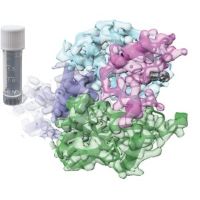Specification
| Description | Recombinant protein from the full-length sequence of Homo sapiens receptor for activated C kinase 1 (RACK1) (NM_006098). |
| Organism | Homo sapiens (Human) |
| Expression Host | Human Cells |
| Tag Info | His or DYKDDDDK. Please contact us if you need further information or require specific designed tag. |
| Purity | Greater than 90% by SDS-PAGE gel |
| Uniprot ID | P63244 |
| Entry Name | RACK1_HUMAN |
| Gene Names | RACK1 GNB2L1 HLC7 PIG21 |
| Alternative Gene Names | GNB2L1 |
| Alternative Protein Names | Receptor of activated protein C kinase 1 (Cell proliferation-inducing gene 21 protein) (Guanine nucleotide-binding protein subunit beta-2-like 1) (Guanine nucleotide-binding protein subunit beta-like protein 12.3) (Human lung cancer oncogene 7 protein) (HLC-7) (Receptor for activated C kinase) (Small ribosomal subunit protein RACK1) [Cleaved into: Receptor of activated protein C kinase 1, N-terminally processed (Guanine nucleotide-binding protein subunit beta-2-like 1, N-terminally processed)] |
| Application | Antigens, Western, ELISA and other in vitro binding or in vivo functional assays, and protein-protein interaction studies; For research & development use only! |
| Buffer | Purified protein formulated in a sterile solution of PBS buffer, pH7.2, without any preservatives |
| Endotoxin | Endotoxin level is < 0.1 ng/µg of protein (<1EU /µg) |
| Length | 317 |
| Molecular Weight(Da) | 35077 |
| Protein Sequence | (The sequence of expressed protein may have some variation from the sequence shown below. Please contact us for the exact sequence.) MTEQMTLRGTLKGHNGWVTQIATTPQFPDMILSASRDKTIIMWKLTRDETNYGIPQRALRGHSHFVSDVVISSDGQFALSGSWDGTLRLWDLTTGTTTRRFVGHTKDVLSVAFSSDNRQIVSGSRDKTIKLWNTLGVCKYTVQDESHSEWVSCVRFSPNSSNPIIVSCGWDKLVKVWNLANCKLKTNHIGHTGYLNTVTVSPDGSLCASGGKDGQAMLWDLNEGKHLYTLDGGDIINALCFSPNRYWLCAATGPSIKIWDLEGKIIVDELKQEVISTSSKAEPPQCTSLAWSADGQTLFAGYTDNLVRVWQVTIGTR |
Background
| Function | FUNCTION: Scaffolding protein involved in the recruitment, assembly and/or regulation of a variety of signaling molecules. Interacts with a wide variety of proteins and plays a role in many cellular processes. Component of the 40S ribosomal subunit involved in translational repression (PubMed:23636399). Involved in the initiation of the ribosome quality control (RQC), a pathway that takes place when a ribosome has stalled during translation, by promoting ubiquitination of a subset of 40S ribosomal subunits (PubMed:28132843). Binds to and stabilizes activated protein kinase C (PKC), increasing PKC-mediated phosphorylation. May recruit activated PKC to the ribosome, leading to phosphorylation of EIF6. Inhibits the activity of SRC kinases including SRC, LCK and YES1. Inhibits cell growth by prolonging the G0/G1 phase of the cell cycle. Enhances phosphorylation of BMAL1 by PRKCA and inhibits transcriptional activity of the BMAL1-CLOCK heterodimer. Facilitates ligand-independent nuclear translocation of AR following PKC activation, represses AR transactivation activity and is required for phosphorylation of AR by SRC. Modulates IGF1R-dependent integrin signaling and promotes cell spreading and contact with the extracellular matrix. Involved in PKC-dependent translocation of ADAM12 to the cell membrane. Promotes the ubiquitination and proteasome-mediated degradation of proteins such as CLEC1B and HIF1A. Required for VANGL2 membrane localization, inhibits Wnt signaling, and regulates cellular polarization and oriented cell division during gastrulation. Required for PTK2/FAK1 phosphorylation and dephosphorylation. Regulates internalization of the muscarinic receptor CHRM2. Promotes apoptosis by increasing oligomerization of BAX and disrupting the interaction of BAX with the anti-apoptotic factor BCL2L. Inhibits TRPM6 channel activity. Regulates cell surface expression of some GPCRs such as TBXA2R. Plays a role in regulation of FLT1-mediated cell migration. Involved in the transport of ABCB4 from the Golgi to the apical bile canalicular membrane (PubMed:19674157). Promotes migration of breast carcinoma cells by binding to and activating RHOA (PubMed:20499158). {ECO:0000269|PubMed:11884618, ECO:0000269|PubMed:12589061, ECO:0000269|PubMed:12958311, ECO:0000269|PubMed:17108144, ECO:0000269|PubMed:17244529, ECO:0000269|PubMed:17956333, ECO:0000269|PubMed:18088317, ECO:0000269|PubMed:18258429, ECO:0000269|PubMed:18621736, ECO:0000269|PubMed:19423701, ECO:0000269|PubMed:19674157, ECO:0000269|PubMed:19785988, ECO:0000269|PubMed:20499158, ECO:0000269|PubMed:20541605, ECO:0000269|PubMed:20573744, ECO:0000269|PubMed:20976005, ECO:0000269|PubMed:21212275, ECO:0000269|PubMed:21347310, ECO:0000269|PubMed:23636399, ECO:0000269|PubMed:28132843, ECO:0000269|PubMed:9584165}.; FUNCTION: (Microbial infection) Binds to Y.pseudotuberculosis yopK which leads to inhibition of phagocytosis and survival of bacteria following infection of host cells. {ECO:0000269|PubMed:21347310}.; FUNCTION: (Microbial infection) Enhances phosphorylation of HIV-1 Nef by PKCs. {ECO:0000269|PubMed:11312657}.; FUNCTION: (Microbial infection) In case of poxvirus infection, remodels the ribosomes so that they become optimal for the viral mRNAs (containing poly-A leaders) translation but not for host mRNAs. {ECO:0000269|PubMed:28636603}.; FUNCTION: (Microbial infection) Contributes to the cap-independent internal ribosome entry site (IRES)-mediated translation by some RNA viruses. {ECO:0000269|PubMed:25416947}. |
| Pathway | |
| Protein Families | WD repeat G protein beta family, Ribosomal protein RACK1 subfamily |
| Tissue Specificity |
QC Data
| Note | Please contact us for QC Data |
| Product Image (Reference Only) |  |

